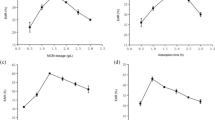Abstract
In the present work we prepared chitosan-coated alginate beads, to use as a chemical chaperone based on the electrostatic interaction between the carboxylate groups of alginate and the ammonium groups of chitosan. This procedure was an attempt for designing a highly efficient chemical chaperone to improve protein stability and refolding. Based on enzyme recovered activity, turbidity, far-UV CD and fluorescence data, alkaline phosphatase can be stabilized and refolded to a higher degree in the presence of alginate capsules compared with unassisted form and was further improved by including chitosan. Finally the maximum yield was obtained when the refolding process was achieved under a well worked out temperature program: incubation of the captured-enzyme for 20 min at 4 °C followed by overnight incubation at 22 °C, which showed that aggregation is a major limitation to refolding.






Similar content being viewed by others
Abbreviations
- ALP:
-
Alkaline phosphatase
- BSA:
-
Bovine serum albumin
- pNPP:
-
p-nitrophenyl phosphate
References
Agashe VR, Hartl FU (2000) Semin Cell Dev Biol 11:15–25
Andi B, West AH, Cook P (2004) Arch Biochem Biophys 421:243–254
Betts SD, King J (1998) Protein Sci 7:1516–1523
Bradford MM (1976) Anal Biochem 72:248–254
Chen MJ, Chen KN, Kuo YT (2007) Biotechnol Bioeng 98(2):411–419
Daly MM, Knorr D (1988) Biotech Prog 4:76–81
Dong XY, Shi JH, Sun Y (2002) Biotechnol Prog 18:11–19
Eftekharzadeh B, Khodagholi F, Abdi A, Maghsoudi N (2010) Carbohydr Polym 79:1063–1072
Fernández M, Villalonga ML, Caballero J, Fragoso A, Cao R, Villalonga R (2003) Biotechnol Bioeng 83(6):743–747
Fink AL (1999) Physiol Rev 79:425–449
Fosset M, Chappelet-Tordo D, Lazdunski M (1974) Biochemistry 13:1783–1788
Fundueanu G, Nastruzzi C, Carpov A, Desbrieres J, Rinaudo M (1999) Biomaterials 20:1427–1435
Garen A, Levinthal C (1960) Biophys Acta 38:470–483
Gombotz WR, Wee SF (1998) Adv Drug Delivery Rev 31:267–285
Guex N, Peitsch MC (1997) Elecrophoresis 18:2714–2723
Haase-Pettingell C, King J (1988) J Biol Chem 263:4977–4983
Hoffman AS (2001) Ann NY Acad Sci 944:62–73
Khodagholi F, Yazdanparast R (2005) Protein J 24:303–313
Khodagholi F, Eftekharzadeh B, Yazdanparast R (2008) Protein J 27:1–6
Koepsell HJ, Tsuchiya HM (1952) J Bacteriol 63:293–295
Kumar R. Siva Sai, Vishwanath KS, Singh SA, Appu Rao AG (2006) Process Biochem 41(11):2282–2288
Li XY, Jin LJ, McAllicter TA, Stanford K, Xu JY, Lu YN, Zhen YH, Sun YX, Xu YP (2007) J Agric Food Chem 55:2911–2917
Mondal K, Bohidar HB, Roy RP, Gupta MN (2006) Biochim Biophys Acta 1764:877–886
Mukhopadhyay A (1997) Adv Biochem Eng Biotechnol 56:106–109
Poncelet D, Poncelet de Smet B, Beaulieu C, Neufeld RJ (1992) In: Goosen MF (ed) Fundamentals of animal cell encapsulation and immobilization. CRC press, Boca Raton
Rezaii N, Khodagholi F (2009) Protein J 28:124–130
Sattarahmady N, Khodagholi F, Moosavi-Movahedi AA, Heli H, Hakimelahi GH (2007) Int J Biol Macromol 41:180–184
Shamala TR, Prasad MS (1995) Biochemistry 30:237–241
Silva CM, Ribeiro AJ, Figueiredo IV, Gonçalves AR, Veiga F (2006) Int J Pharm 311:1–10
Wang J, Lu D, Lin Y, Zh Liu (2005) Biochem Chem 24:269–277
Xie Y, Wetlaufer DB (1996) Protein Sci 5:517–523
Zohar-Perez C, Chet I, Nussinovitch A (2004) Food Hydrocoll 18:249–258
Acknowledgments
We would like to thank the research council of the Shahid Beheshti University of Medical Sciences for the financial support of this investigation.
Author information
Authors and Affiliations
Corresponding author
Rights and permissions
About this article
Cite this article
Khodagholi, F., Farahmand, S. & Tusi, S.K. Designing a Highly Efficient Chemical Chaperone System Using Chitosan-Coated Alginate. Protein J 29, 343–349 (2010). https://doi.org/10.1007/s10930-010-9258-0
Published:
Issue Date:
DOI: https://doi.org/10.1007/s10930-010-9258-0




